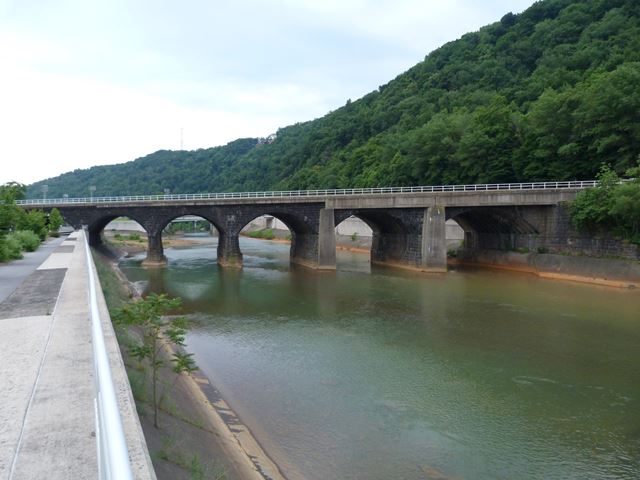We Recommend:
Bach Steel - Experts at historic truss bridge restoration.
BridgeHunter.com Phase 1 is released to the public! - Visit Now
Stone Bridge

Primary Photographer(s): Nathan Holth
Bridge Documented: July 6, 2014
Railroad (Norfolk Southern, Former Pennsylvania Railroad) Over Conemaugh River, PA-56, and Iron Street
Johnstown: Cambria County, Pennsylvania: United States
1888 By Builder/Contractor: Alexander G. Sparks and Shipley W. Evans of Philadelphia, Pennsylvania and Engineer/Design: William H. Brown
1929
58.0 Feet (17.7 Meters)
580.0 Feet (176.8 Meters)
Not Available
7 Main Span(s) and 3 Approach Span(s)
Not Applicable

View Information About HSR Ratings
Bridge Documentation
View Historic American Engineering Record (HAER) Documentation For This Bridge
HAER Data Pages, PDF
This bridge is a well-known Johnstown landmark. It is significant for multiple reasons. From an engineering standpoint, it is a rare example of a skewed stone arch bridge. The skew is achieved by the offset of the stone ribs of the bridge. The bridge is also noteworthy as the first major stone bridge designed by William H Brown, who went on to design many enormous stone arch bridges for the Pennsylvania Railroad. Brown's choice of stone arch bridges for the railroad during this period in history, which in some cases (including this bridge) resulted in the replacement of pre-existing metal truss bridges with stone bridges, is in reverse to the traditional evolution of bridge materials where typically stone is a material replaced by use of iron and steel.
This bridge was noted as one of the only bridges in Johnstown not destroyed in the great 1889 Johnstown Flood. While this might sound like a good thing, the bridge actually trapped debris flowing down the river, including people. The debris subsequently caught fire and killed the people trapped in the debris before they could be rescued.
The bridge today looks like a concrete arch bridge from the upstream side. This is due to an alteration in 1929. While it appears visually as though the bridge was widened at this time, the bridge was apparently always a four track bridge as seen today, and the concrete section was merely a repair for the flood-damaged upstream side of the bridge.
In contemporary history, the bridge is a recognized historic landmark and a successful effort was completed to provide decorative lighting for the bridge, allowing the bridge to be enjoyed at night as well.
![]()
Photo Galleries and Videos: Stone Bridge
Bridge Photo-Documentation
Original / Full Size PhotosA collection of overview and detail photos. This gallery offers photos in the highest available resolution and file size in a touch-friendly popup viewer.
Alternatively, Browse Without Using Viewer
![]()
Bridge Photo-Documentation
Mobile Optimized PhotosA collection of overview and detail photos. This gallery features data-friendly, fast-loading photos in a touch-friendly popup viewer.
Alternatively, Browse Without Using Viewer
![]()
Maps and Links: Stone Bridge
Coordinates (Latitude, Longitude):
Search For Additional Bridge Listings:
Bridgehunter.com: View listed bridges within 0.5 miles (0.8 kilometers) of this bridge.
Bridgehunter.com: View listed bridges within 10 miles (16 kilometers) of this bridge.
Additional Maps:
Google Streetview (If Available)
GeoHack (Additional Links and Coordinates)
Apple Maps (Via DuckDuckGo Search)
Apple Maps (Apple devices only)
Android: Open Location In Your Map or GPS App
Flickr Gallery (Find Nearby Photos)
Wikimedia Commons (Find Nearby Photos)
Directions Via Sygic For Android
Directions Via Sygic For iOS and Android Dolphin Browser
USGS National Map (United States Only)
Historical USGS Topo Maps (United States Only)
Historic Aerials (United States Only)
CalTopo Maps (United States Only)


